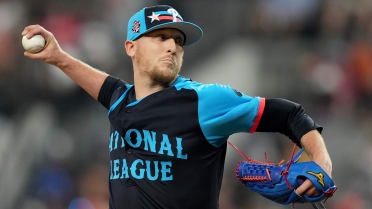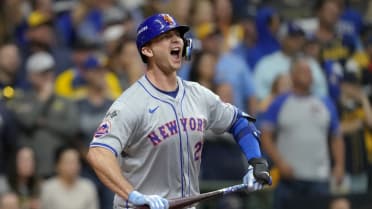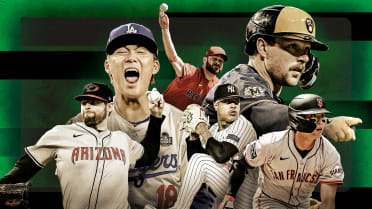Is this Rangers slugger making a case for MVP?
Joey Gallo leading American League in OPS (1.113)
The "Joey Gallo has a legitimate Most Valuable Player case" argument should really begin and end with this statement:
He's been the best hitter in the American League, by OPS or wRC+ or wOBA or any metric you like, and he's doing it while playing a capable defense in center field.
That's it. Full stop. When you're a center fielder hitting .293/.426/.687, the best line in the league, with 15 homers before the end of May, you're one of the best players in baseball. There is no argument here.
It's more complicated than that, obviously. No one thinks Gallo is actually a better all-around player than Mike Trout or Mookie Betts. He doesn't have the track record of George Springer. He's not the shocking out-of-nowhere breakout pushing a first-place team like Jorge Polanco. That he's been the best hitter in the AL is not the same thing as saying he will be the best hitter in the AL.
He's probably not going to win the MVP Award, partially because the Rangers, despite somehow leading the Majors in runs per game, are unlikely to make the playoffs, which matters more to people when thinking about an individual award than I'd argue it should. But he's going to get some votes, and they're going to be deserved.
For the last two years, Gallo was merely the high-powered slugger who crushed home runs (81 in 2017-'18, fourth-most in baseball) while striking out a ton (36.3 percent, second-most behind Chris Davis), which limited him to a .208 batting average, third-lowest among qualified hitters. That was still useful -- the batting average doesn't really matter, and he had back-to-back three-WAR seasons (per FanGraphs), making him a solid regular.
But this year, he looks like a very different hitter, even though he's not actually striking out any less. That's what has made him a star. It's what's made him as valuable in one-third of a season as he was in either 2017 or 2018. Here's what's changed, and why it matters.
He's not going after bad pitches as much.
"Don't swing at balls, mash strikes," while far simpler said than done, is just about the best thing any hitter can do. Since the start of 2018, the Majors have hit .283 with a .488 slugging on pitches inside the zone, and .155 with a .214 slugging outside the zone. Gallo (.269/.671 in, and .115/.209 out) is no different.
Gallo spoke at length with Levi Weaver of The Athletic (subscription required) in February about the changes he was working on with new hitting coach Luis Ortiz, including subtle changes to his swing mechanics. Ortiz offered this near-perfect thought: "He’s so strong, he doesn’t need to swing as hard, he just has to be accurate."
We can't measure how hard he's swinging -- yet -- but given those stark differences in production inside the zone and out, it would make a lot of sense if Gallo was holding back slightly on the oomph in order to make better decisions. Looking at the biggest drops in chase rate, of those who had 400 plate appearances last year and 150 this year, no American League hitter has cut their out-of-zone swings as much as Gallo has, down from 32.7 percent to 25.3 percent.
-10.1%, Dansby Swanson, ATL
-8.0%, Freddie Freeman, ATL
-7.4%, Gallo, TEX
Not unrelated: Gallo's walk rate is up from 12.8% to 19.1%. That's a gain of +6.3%, and that's the largest jump in baseball. Fewer swings outside the zone lead to less weak contact and more walks. This isn't all rocket science, here.
Again, it's not an easy thing to do. But if you can swing at fewer of the pitches that are less likely to lead to success, it's a winning strategy.
He's ignoring the shift. Correctly.
This is always going to be the divisive thing about Gallo, who sees a shift on 96 percent of his plate appearances, more than any other hitter in baseball. "Why," fans and media like to ask, "doesn't he just bunt or go the other way?"
Maybe he should. There's some evidence that suggests maybe it's a good idea, though that was based on the "old" Gallo, not the current one. But there's also three problems with it:
1) It's not easy. People seem to assume that it is, but for a player who has difficulty making enough contact in the first place, asking him to make that contact in a specific direction is even more unlikely. ("It's not that simple. It's not that easy against a guy who is throwing 107 with a ton of movement like Verlander," he said to the Dallas Morning News last year.)
2) It might not matter. How many bunts or opposite-field batted balls would Gallo need to do for the shifts to go away? It's not one or two. Is it 10? 50? What if the answer is "never," because if he's spending all his time trying to hit singles, the defense has already won?
3) It changes who Gallo is. Think about this from the pitcher's point of view. You're about to face a hitter with arguably the most raw power in the game. If, by simply having your fielders stand in a different spot, you can make that slugger willfully try to change his swing away from that power, wouldn't you want that 10 times out of 10? Even if it comes a the cost of a few singles?
Gallo knows all this. Just look at what he said to ESPN's Jeff Passan earlier this month:
"You don't just learn to hit the other way," said Gallo. "If I'm slapping singles down the line, am I still Joey Gallo? Am I still productive? I can't try to play to that, because it's not me, and I like to play in the Major Leagues. I get paid to drive guys in and hit the ball out of the ballpark."
That's exactly right, and you can see it in the numbers. With the shift on, look at the percentage of Gallo's batted balls that he's hit to the opposite field. It's less.
2017 -- 20%
2018 -- 23.3%
2019 -- 14.8%
With the shift on, he's hit exactly two opposite-field grounders this year. One was a groundout to the third baseman, playing in the shortstop position. One was an infield single, but clearly unintentional on Gallo's part.
Perhaps the best way to think about it is like this: Gallo isn't trying to "beat the shift," he's not going opposite field more -- less, actually -- and he's hitting like one of baseball's most elite sluggers. Why in the world would you want him to do anything to change that?
He's hitting even harder than ever.
It's not like Gallo actually needed to hit any harder than he already did. In 2017-18, he had the second-best average exit velocity (93.5 mph) and the third-best hard-hit rate (50.9%). He's known for gloriously, majestically, mashing baseballs.
This year, that's all up. His 96.9 mph exit velo is best in baseball, among those with 50 batted balls, and he's got the best hard-hit rate in baseball, too, ahead of some very impressive names.
1) Gallo, TEX -- 60.7%
2) Josh Bell, PIT -- 59.1%
3) Anthony Rendon, WSH -- 57.3%
4) Christian Yelich, MIL -- 54.8%
5) Jose Abreu, CWS -- 54.3%
That might seem counter-intuitive, given that Ortiz said that not swinging as hard might be a good thing. Then again, this might come all the way back to better decision-making. In 2017-'18, Gallo had an 86.1 mph exit velocity on contact outside the zone and 95.2 mph inside it. Simply making more contact inside the zone and less outside it would seem to do a lot to boost that hard-hit rate.
He's elevating... less, and that's a good thing.
There's something missing here, of course. For what little batting average matters, it's interesting to note that Gallo's is up from .206 to .293 -- that's the third-largest jump -- but he's not striking out less (35 percent, third-highest in the Majors), and all the extra walks don't matter here. How?
That's partially because of his .406 BABIP, which is hilariously unsustainable; it's only the third-highest this year, but it would be one of the 10 highest in baseball history, so it's almost certainly not something that is going to keep up all year long.
That's not the same as saying "it's good luck," not with the way he's scorching it. His expected batting average, a Statcast metric based on exit velocity, speed, launch angle, and contact, is .273, not that far off his actual .290. And his expected BABIP, based on non-homer balls in play is .407, which nails that .406 almost exactly. It might not be sustainable, but it's not exactly about good luck, either. He's earning this.
So if he's still striking out as much as he ever did, and still seeing the shift as much as ever, and not going the other way to pick up cheap hits, and not hitting fewer grounders than he did before ... where is this average jump coming from?
It's partially, perhaps primarily, about that better contact, as we detailed above. But it's also about the fact that Gallo is doing something that's the opposite of what you expect to hear in 2019 baseball: He's not hitting it higher. He's hitting it lower.
That can be seen in the fact that his launch angle is down from 22 degrees in 2017-'18, tied for baseball's highest, to 19.8 degrees, merely 19th-highest, but it's also about what's happening when he's not hitting his usual 30 percent grounders. It's what's happening in the other 70 percent of batted balls that's interesting.
He's cut his fly ball rate from 49.8 percent to 38.1 percent, baseball's third-largest drop. That would be a problem if they were being converted to grounders, but they're not. They're turning into line drives; his 32.1 percent liner rate is up 11.5 points from last year, and that's the second-highest improvement behind one of the very few hitters having a better year, Cody Bellinger.
Line drives are great for most players, and especially for Gallo. Over his career, he's hit .687 with an 1.109 slugging on liners, and a wild .778/1.444 this year. He gets more slugging on fly balls (1.284 career) but less batting average (.358). He's also mostly eliminated popups, which are essentially strikeouts; he has just 5 this year after 53 over the last two years.
This, essentially, is how he "beats the shift." It's not going the other way. It's hitting over the infielders, no matter where they are.
Don't forget, it's not just about the hitting.
If we're talking about an MVP case, it can't just be about offense. To look at Gallo's size (listed at 6-foot-5, 235 pounds) and big-power, swing-and-miss profile, you might think of him as a prototypical slow-footed designated hitter type. Part of what makes Betts and Trout so valuable are what they do in other aspects of the game.
Gallo will never be mistaken for Betts in the field or on the bases, but to pigeonhole him as a bat-only player doesn't tell the true story. He's fast, to begin with, with 66th percentile Sprint Speed. (His 27.4 ft/sec mark is slightly better than the 27.0 ft/sec league average, and similar to players perceived to be faster like Jason Heyward and Kolten Wong.) He's got a cannon, too; Gallo currently has three of the nine hardest outfield throws in baseball this year, topping out at 100.4 mph on March 31.
He's also athletic enough that he's started 18 games in center field, with positive reviews by most of the defensive metrics.
“Playing center field,” Gallo said to MLB.com's T.R. Sullivan earlier this week. “Who would have thought back home five years ago, I would be starting in center field in the big leagues? No chance.”
The Rangers recalled Delino DeShields Jr. on Wednesday, the team's Opening Day center fielder, though he may be up only for a few days until Elvis Andrus returns. If Gallo does end up playing center for a good chunk of the season, he might end up doing something rarely seen in baseball history.
According to Baseball-Reference, only five players who stood 6-foot-5 or taller have ever qualified for the batting title in a season where they played center at least 40% of the time. Dexter Fowler did it seven times, Alex Rios three times, Von Hayes twice, and Dave Winfield and Heyward once apiece, with that last one also coming so far in 2019. Gallo would be the sixth.
Only five players listed at 235 pounds or heavier have played center at least 40% of the time in a season, too. Trout is working on his eighth year, Marlon Byrd did it three times, Josh Hamilton twice, and Heyward's 2019 counts there too. If Heyward, who spends most of his time in right field, doesn't qualify, Gallo would be the first. No one has ever been this big and this tall and played center, to say nothing of playing it well.
Gallo isn't going to win the MVP, most likely. There are too many factors working against him. But he's going to get votes, and potentially very high ones. You don't crush the ball like this while playing center field without being "valuable," however you define that.
Mike Petriello is a stats analyst for MLB.com, focusing on Statcast and Baseball Savant, and is also a contributor to MLB Network.




